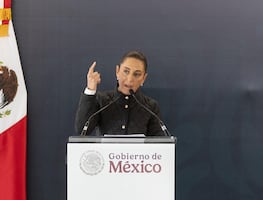Más Información

“Vamos a dar apoyo a los pequeños agricultores por sequía en Sonora”; Claudia Sheinbaum instruye a Berdegué

Derrota de México en disputa por maíz transgénico contra EU; estos son los argumentos de Sheinbaum y AMLO para prohibirlo

Óscar Rentería Schazarino, ha operado contra CJNG, Viagras y Templarios; es el nuevo secretario de Seguridad en Sinaloa

Claudia Sheinbaum pide respeto para Maru Campos; gobernadora anuncia acuerdo para transporte público

Claudia Sheinbaum anuncia los Centros de Cuidado Infantil en Chihuahua; inaugura hospital en Ciudad Juárez
The grand exhibition "Teotihuacan: city of water, city of fire," which features more than 200 archaeological objects discovered during the explorations of the pyramids of the Sun, the Moon, and the Feathered Serpent , will be presented at the Phoenix Art Museum in Arizona, starting October 6 .
The exhibition will show The City of Gods featuring similarities between the ancient urban life of pre-Columbian Mesoamerica and contemporary cities, the National Institute of Anthropology (INAH) reported in a statement .
This is the first large-scale exhibition about Teotihuacan in the United States in more than 20 years and is organized by the Ministry of Culture and INAH, jointly with Los Angeles County Museum of Arts and the de Young Museum, in San Francisco , where it was presented at the end of last year.
Contemporary of ancient Rome , the city of Teotihuacán reached its maximum splendor in the year 400 BC and was one of the most magnificent and important places in the world; it is currently the most visited archaeological site in Mexico and is part of the UNESCO World Heritage List since 1987 .
Among the objects that visitors will be able to appreciate there are fragments of murals from the collection of the Fine Arts Museum of San Francisco (FAMSF) , altogether with others that come from the same residential complex of Teotihuacán.
In 1986 , the FAMSF repatriated a number of murals as part of an agreement with INAH, and established a collaborative conservation and exhibition program.
Along with the murals, objects and rituals from the three pyramids will be put on display, as well as ceramic works and stone sculptures found in the old residential areas of the city, where people from different parts of Mexico lived.
"In ancient times, Teotihuacan was an unrivaled civilization, and it has many parallels with our contemporary culture that can help us to reimagine an almost universal phenomenon of humanity, which is the construction of cities," said curator Matthew H. Robb .
The also curator of the Fowler Museum of the University of California in Los Angeles recalled that this site was a city in the modern sense of the word, a place where a multiethnic population was led by the same religious, social, and economic forces and ideas.
"Teotihuacan was a civilization that was ahead of its time, and some of the lessons we have learned from these objects could perfectly apply to modern times," he said.
The archaeological team, led by Mexican researchers, worked on the main pyramids and included international specialists, such as professors from the Teotihuacan Research Laboratory , the School of Human Evolution and Social Change, from Arizona State University .
Since the last exhibition of Teotihuacán pieces in the 90s , these specialists have made significant discoveries.
By gathering objects from various excavations and inviting visitors to understand the context of specific sites within the city, "Teotihuacan: city of water, city of fire" offers a unique opportunity to learn more about a transcendental place in the historic landscape and cultural heritage of the Americas.
Throughout the exhibition, the museum will work alongside the ASU and its first-class faculty to create participatory programs for all ages, with the aim of increasing the experience around these archaeological treasures of the world heritage, on display in the state of Arizona for the first time, where it will remain until January 19, 2019 .
dm






